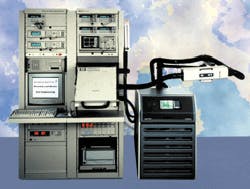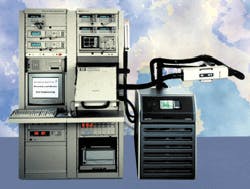Lockheed Martin cuts test station costs with HP VXIbus technology
Engineers at Lockheed Martin Electronics and Missiles in Orlando, Fla., needed VXIbus technology for a test system designed to lower test system development and support costs and shorten development cycles.
They found their answer with VXIbus technology from Hewlett-Packard in San Jose, Calif. Lockheed Martin test engineers used the technology to create a re-usable, re-configurable Common Core Test Station.
"Since the initial deployment of the Common Core Test Station in late 1997, the original team goal of reducing the cost of a turnkey test station by 50 percent has been met and continues to be exceeded," says Paul DiStefano, Lockheed test engineering manager.
"Additional strategies are planned to further reduce the cost by a total of 65 percent," he adds. "This new test strategy has resulted in documented reductions in development costs of more than 50 percent along with development cycle time reductions in excess of 25 percent."
Hewlett-Packard uses standard plug-and-play instrument software that "provides universal support by commercially available test development software and portability from one generation to the next," DiStefano says. "This enables faster development times and when newer models replace the older hardware, software rewrites and system redesigns are minimized. In addition, Lockheed Martin developed a standard test executive software package to use with every Common Core platform resulting in more than 50 percent software re-use."
Lockheed Martin and Hewlett-Packard engineers also developed a low-level circuit card thermal test to simulate the operational environment of a guidance section, DiStefano notes. They used "the Temperature Forcing Unit and VXI arbitrary waveform generator modules to better simulate electrically noisy environments by modulating random noise onto signal lines," he explains. "The more robust test has allowed manufacturing defect detection to be driven down to the circuit-card level where rework costs are much lower than removing the guidance section circuit cards from the missile housing."
The Common Core Test Station is PC-based with a Windows NT Operating System. Engineers use a rack-mounted, desktop-type PC to retrofit PC technology with little impact to the remaining system. They write test applications software in the C programming language.
The PC interfaces to the VXI mainframe through a MXI 2 high-speed interface to a slot 0 controller. The 13-slot, C-size VXI mainframe contains all general-purpose VXI instrument modules such as general-purpose switching, digital multimeter, waveform generator, 1553 Interface, RF multiplexer, and 25 MHz digital I/O. The remainder of the Common Core Test Station includes power conditioning and distribution, GPIB instrumentation, UUT power sources, and the computer controlled uninterruptable power source.
"The use of industry standard, commercial VXI hardware components available from multiple suppliers minimizes rapid obsolescence and sole sourcing by providing alternate and competing sources for system components," DiStefano says. "The result is a low-cost system with an open architecture for easy expansion and future performance upgrades."
Since 1997 Lockheed Martin officials have deployed 12 systems across eight programs in the Missile, Fire Control, and Launch Vehicle program areas. Online test applications include circuit card assemblies, seeker assemblies, avionics sections, guidance electronics, all-up missiles, targeting pods, safe and arm units, fire control circuit cards, and satellite launch vehicle electronics. Twenty additional Common Core Systems are planned over the next two years. — J.M.
For more information contact Hewlett-Packard by phone at 800-752-0900, or on the World Wide Web at http://www.hp. com. For more information on Lockheed`s Common Core Test Station contact Paul DiStefano by phone at 407-356-7498.
Vexcel data-capture system helps NASA map the Earth
NASA officials needed a data-capture system to store information downlinked from space during the September-scheduled Space Shuttle mission. The Vexcel Direct Capture System (VxDCS) system from Vexcel Corp. in Boulder, Colo., met their needs.
NASA scientists will use the VxDCS data-capture system to gather information to help them map nearly 80 percent of the Earth`s landmass with interferometric synthetic aperture radar — better known as IFSAR. The shuttle mission is called Space Shuttle Topography Mission — or SRTM.
As the shuttle`s radar antennas collect the interferometric data, the shuttle is to relay it to ground-receiving facilities equipped with Vexcel`s direct capture system. Computers on the ground will process the information in real time to generate detailed topographic maps.
Technicians on the ground will download SRTM data via VxDCS and process it to verify the quality of the data. They are using the Vexcel system to test the quality of the data as sensors collect it since the mission spans only 11 days and they will have few, if any, opportunities to replace bad data. The system will enable them to make adjustments to shuttle equipment while in orbit, if necessary.
Interferometry takes two radar images from slightly different locations, which enables experts to calculate surface elevation. Before this mission, government experts have gathered interferometric topographic data only from aircraft. —J.K.
For more information on the Vexcel Direct Capture System, contact the company by phone at 303-444-0094, by fax at 303-444-0470, by post at 4909 Nautilus Court, Boulder, Colo. 80301, or on the World Wide Web at http://www. vexcel.com/.
The Common Core Test Station from Lockheed Martin Electronics and missiles uses VXIbus technology from Hewlett-Packard.

